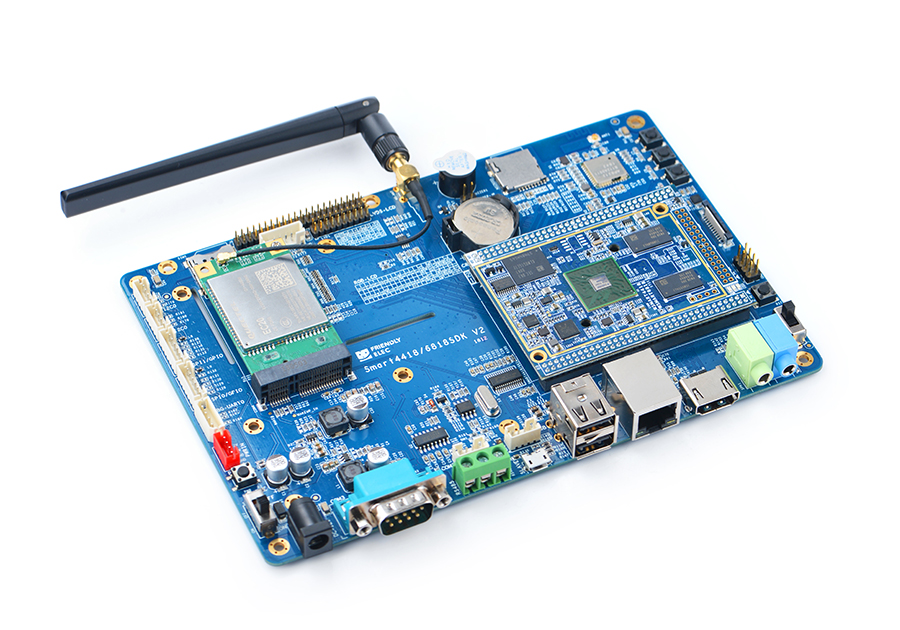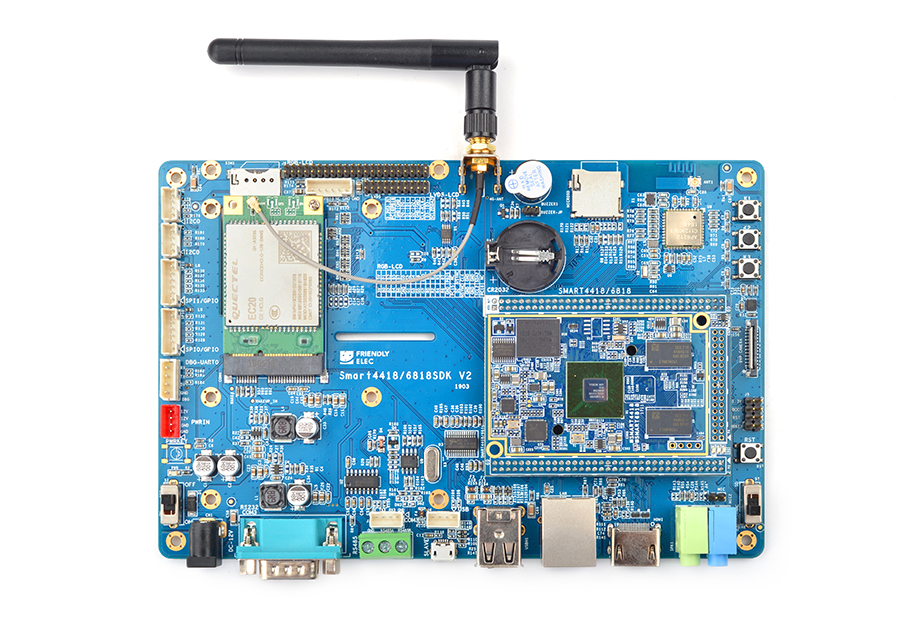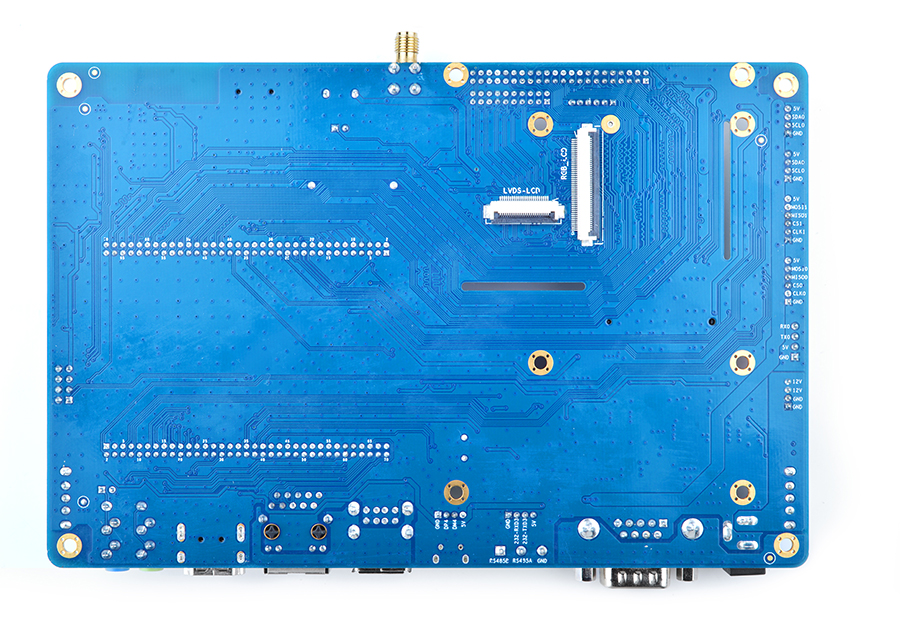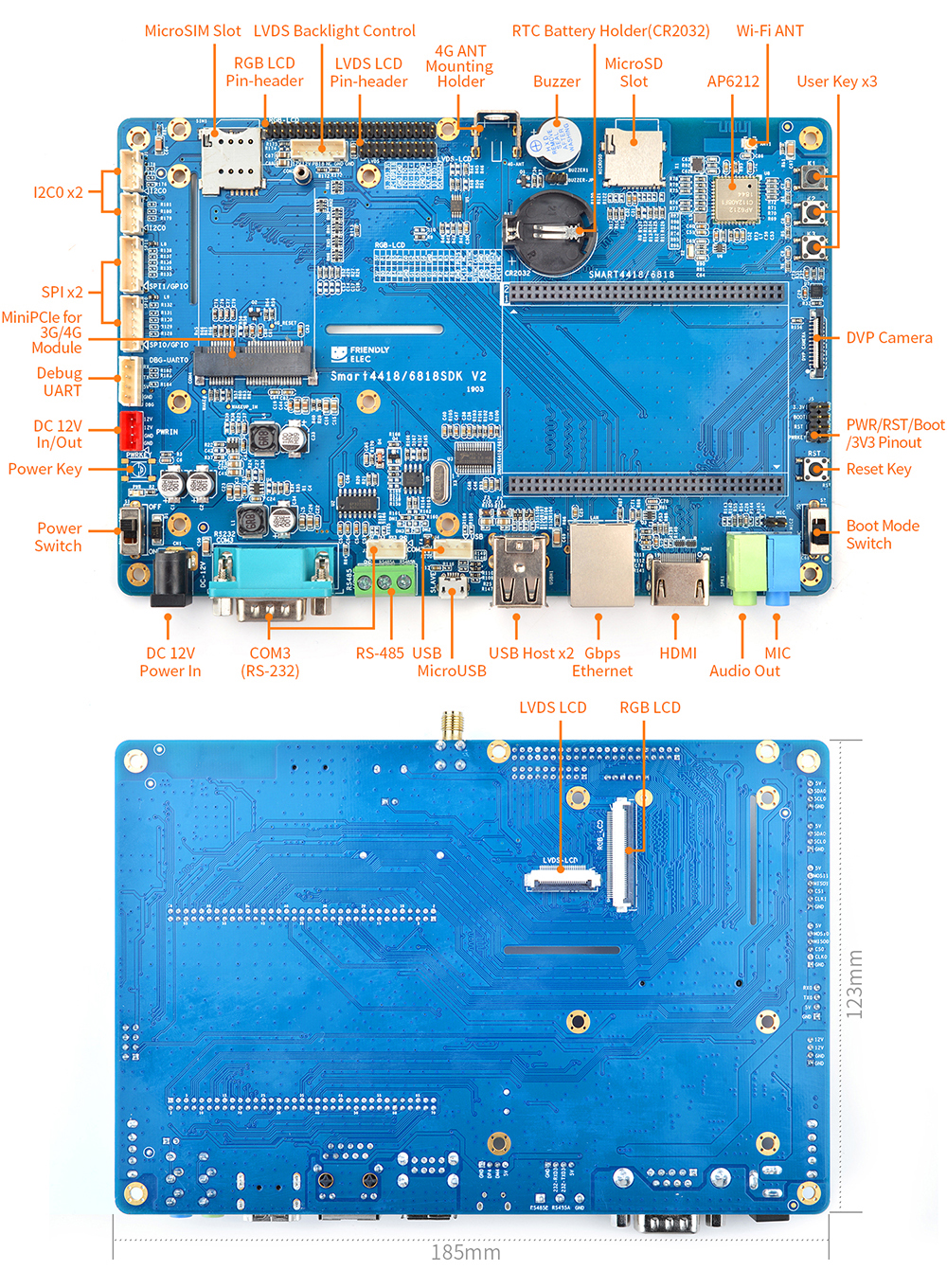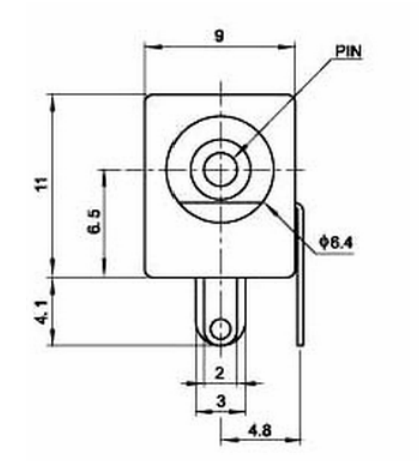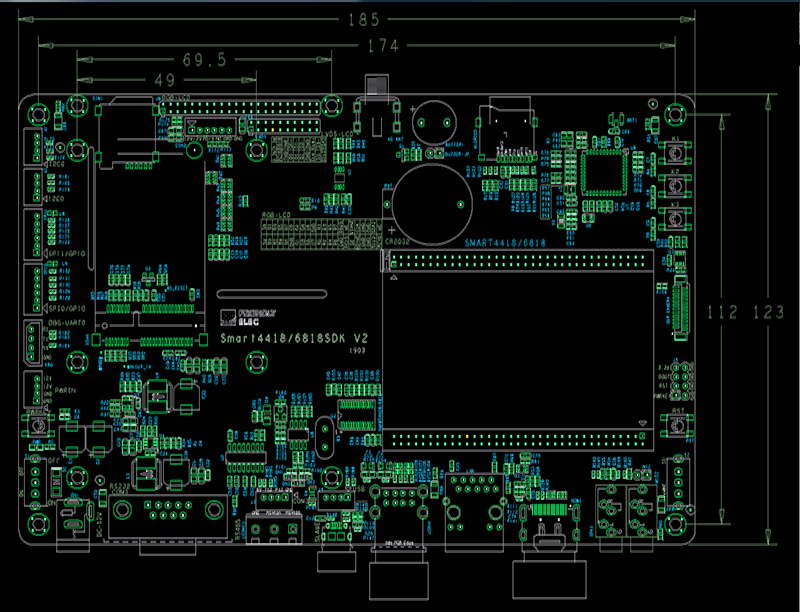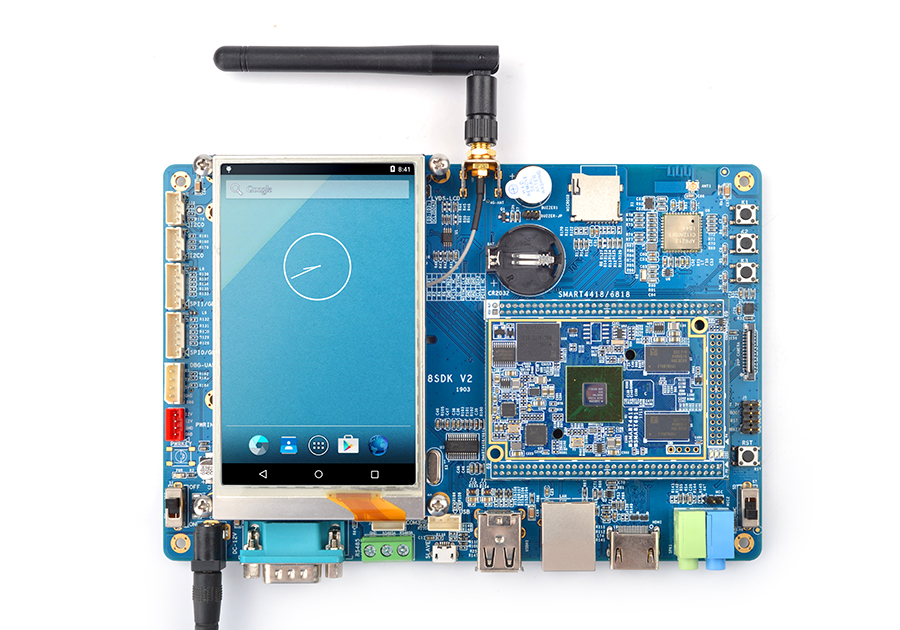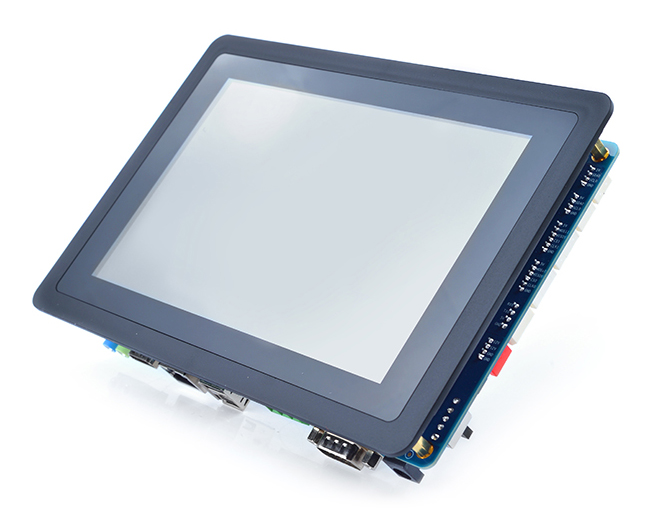Difference between revisions of "Smart4418/6818SDK V2 1812"
From FriendlyELEC WiKi
| Line 2: | Line 2: | ||
==Introduction== | ==Introduction== | ||
| + | [[File:Smart4418_6818SDK_V2_1812-1.jpg|thumb|500px|Overview]] | ||
| + | [[File:Smart4418_6818SDK_V2_1812-2.jpg|thumb|500px|Front]] | ||
| + | [[File:Smart4418_6818SDK_V2_1812-3.jpg|thumb|500px|Back]] | ||
| + | * The Smart4418/6818SDK V2 1812 carrier board populates popular interface pins from the the Smart4418/6818 CPU board. These interface pins include HDMI, USB Host, MicroSD card slot, RS-233 port, RS485 port, RJ-45 Ethernet port, 3.5mm audio input and output, 4G module interface, MicroSIM card slot etc. It has some onboard hardware resources such as buzzer, buttons, RTC battery, microphone etc. All the popular interfaces and ports are on the same side. This layout makes it easy for customers to make a customized case for it. This carrier board can work with FriendlyElec's various LCDs such as HD702, HD702V, S430 LCD etc. | ||
| + | * In order for users to test and develop prototypes this Smart4418/6818SDK carrier board also populates DVP camera interface, SPI, GPIO, I2C, UART and has onboard AP6212 WiFi module, PCB antenna, IPX interface, RTC battery interface. Users can easily connect various devices to this board for testing. This meets the requirements for fast prototyping in various industrial applications. | ||
| + | * The Smart4418/6818SDK V2 1812 carrier board has both RGB LCD interface and LVDS LCD interface. It can work with FriendlyElec's [http://wiki.friendlyarm.com/wiki/index.php/LCD-HD702 HD702 LCD], [http://wiki.friendlyarm.com/wiki/index.php/LCD-HD702 HD702V LCD],[http://wiki.friendlyarm.com/wiki/index.php/LCD-S430 S430 LCD]. Its RGB LCD interface and LVDS LCD interface can be used to test other LCDs as well. | ||
| + | |||
| + | ==Hardware Spec== | ||
| + | [[File:Smart4418_6818SDK_V2_Features.jpg|thumb|550px|Features]] | ||
| + | |||
| + | ::{| class="wikitable" | ||
| + | |- | ||
| + | |Carrier Board Type ||Smart4418/6818SDK V2 1812 | ||
| + | |- | ||
| + | |Dimension || 185 x 123(mm) | ||
| + | |- | ||
| + | |Applicable || [http://wiki.friendlyarm.com/wiki/index.php/Smart4418/zh Smart4418] | ||
| + | |- | ||
| + | |Wi-Fi/Bluetooth || Onboard Wi-Fi Bluetooth module, PCB antenna and IPX Wi-Fi antenna interface | ||
| + | |- | ||
| + | |MiniPCIe Interface || 4G module, only for text message, no voice service, onboard IPX to SMA antenna interface | ||
| + | |- | ||
| + | |SIM Card Slot || Pop-up MicroSIM card slot | ||
| + | |- | ||
| + | |DVP Camera Interface || 24pin, 0.5mm 5mm pitch, FPC seat <br /> DVP Camera interface, ITU-R BT 601/656 8-bit | ||
| + | |- | ||
| + | |HDMI Output || 1 x HDMI A Type, supports HDMI 1.4a(Smart4418) <br /> supports 1080p 30-frame video output | ||
| + | |- | ||
| + | |TTL Serial Port || 1 x 3-wire serial port (UART0), 2.54mm pitch connector, it is by default used as a debug serial port | ||
| + | |- | ||
| + | |RS485 Serial Port || 1 x 3-wire serial port (UART2), 5.08mm pitch connector | ||
| + | |- | ||
| + | |RS232 Serial Port || 1 x 3-wire serial port (UART3), DB9 male connector | ||
| + | |- | ||
| + | |USB Host || 3 x USB port, populated from USB 2.0 hub(compatible with USB 1.1)<br />2 x USB type A port, 1 x 2.0mm pitch PH-4A connector | ||
| + | |- | ||
| + | |USB Slave || 1 x MicroUSB port, only for data transmission | ||
| + | |- | ||
| + | |Audio Input and Output || populated from Smart4418/Smart6818 CPU board<br />supports audio recording and play <br /> 3.5mm audio jack and MIC input <br /> onboard Microphone | ||
| + | |- | ||
| + | |Ethernet || populated from Smart4418/Smart6818 CPU board, 1000/100/10M | ||
| + | |- | ||
| + | |Button || PWRKEY(power button)<br /> RST(reset button)<br /> K1/K2/K3 programmable buttons | ||
| + | |- | ||
| + | |LED || 2 x GPIO programmable LED(on Smart4418/Smart6818 CPU board) | ||
| + | |- | ||
| + | |RTC Battery Interface|| Onboard RTC battery interface (CR2032) | ||
| + | |- | ||
| + | |Buzzer || 1 x PWM buzzer | ||
| + | |- | ||
| + | |SPI || 2 x SPI interface(SPI0, SPI1), 2.0mm pitch PH-4A connector<br /> it can be used as GPIO pins | ||
| + | |- | ||
| + | |MicroSD Card Slot || pop-up MicroSD card slot | ||
| + | |- | ||
| + | |I2C || 2 x I2C0 interface, 2.0mm pitch PH-4A connector | ||
| + | |- | ||
| + | |RGB LCD Interface || RGB LCD interface(45pin, 0.5mm pitch FPC seat) <br /> supports FriendlyElec's one-wire touch technology<br /> supports backlight control<br /> supports capacitive touch panel<br /> supports RGB888 <br /> supports full-color TFT LCD <br /> populated to 22 x 2Pin 2.0mm pitch pin-header | ||
| + | |- | ||
| + | |LVDS Interface || LVDS LCD interface(24pin, 0.5mm pitch FPC seat) <br /> i2c touch panel<br /> supports backlight control<br /> supports capacitive touch panel<br />populated to 10 x 2 Pin 2.0mm pitch pin-header | ||
| + | |- | ||
| + | |LVDS power interface || 2.0mm pitch PH-6A connector, it works as power input for LVDS | ||
| + | |- | ||
| + | |LCD Mounting Hole || applicable for FriendlyElec's HD702, HD702V and S430 LCD etc | ||
| + | |- | ||
| + | |Other Resources || 1 x Onboard EEPROM, 1 x 3-Axis Digital Accelerometer<br /> 4 x 2Pin 2.54mm pitch pin-header, 1 x 3.3V, 1 x boot selection used to select boot from eMMC or MicroSD(HIGH means booting from eMMC and LOW means booting from MicroSD), 1 x RST, 1 x PWRKEY, 4 x GND | ||
| + | |- | ||
| + | |Power Supply || DC 9V~15V/2A, when use LVDS to control backlight it is recommended to use a 12V/3A power supply | ||
| + | |} | ||
| + | |||
| + | ==Diagram, Layout and Dimension== | ||
| + | ===Layout=== | ||
| + | *'''RGB LCD Interface(on the back side of the carrier board, 0.5mm pitch 44Pin FPC seat)''' | ||
| + | ::{| class="wikitable" | ||
| + | |- | ||
| + | |Pin# || Name || Description | ||
| + | |- | ||
| + | |1, 2 || VDD_5V || 5V output, used to power LCD | ||
| + | |- | ||
| + | |11,20,29,37,38,39,40,45|| DGND || Ground | ||
| + | |- | ||
| + | |3-10 || Blue LSB to MSB || RGB blue | ||
| + | |- | ||
| + | |12-19 || Green LSB to MSB || RGB green | ||
| + | |- | ||
| + | |21-28 || Red LSB to MSB || RGB red | ||
| + | |- | ||
| + | |30 || GPIOB25 || GPIO pin, available for users | ||
| + | |- | ||
| + | |31 || GPIOC15 || used to detect LCD type <br> | ||
| + | used for backlight control and resistive touch panel. Users cannot change it. | ||
| + | |- | ||
| + | |33 || VDEN || indicates whether RGB signals are valid | ||
| + | |- | ||
| + | |34 || VSYNC || vertical synchronization | ||
| + | |- | ||
| + | |35 || HSYNC || horizontal synchronization | ||
| + | |- | ||
| + | |36 || LCDCLK || LCD clock, Pixel frequency | ||
| + | |- | ||
| + | |41 || I2C2_SCL || I2C2's clock. It transmits capacitive touch panel's signals | ||
| + | |- | ||
| + | |42 || I2C2_SDA || I2C2's data. It transmits capacitive touch panel's data | ||
| + | |- | ||
| + | |43 || GPIOC16 || capacitive touch panel's interrupt. It works together with I2C2 | ||
| + | |- | ||
| + | |32, 44 || NC || Not connected | ||
| + | |} | ||
| + | |||
| + | *'''LVDS LCD接口(板子背面,0.5mm间距24 Pin FPC贴片座)''' | ||
| + | ::{| class="wikitable" | ||
| + | |- | ||
| + | |Pin# || Name || Description | ||
| + | |- | ||
| + | |1-3 || VDD_5V || 5V输出, 可以给LCD模组供电 | ||
| + | |- | ||
| + | |6,9,12,15,18,24 || GND || 参考地, 0电位 | ||
| + | |- | ||
| + | |4 || LVDS_D0- || LVDS差分数据0负极输出 | ||
| + | |- | ||
| + | |5 || LVDS_D0+ || LVDS差分数据0正极输出 | ||
| + | |- | ||
| + | |7 || LVDS_D1- || LVDS差分数据1负极输出 | ||
| + | |- | ||
| + | |8 || LVDS_D1+ || LVDS差分数据1正极输出 | ||
| + | |- | ||
| + | |10 || LVDS_D2- || LVDS差分数据2负极输出 | ||
| + | |- | ||
| + | |11 || LVDS_D2+ || LVDS差分数据2正极输出 | ||
| + | |- | ||
| + | |13 || LVDS_CLK- || LVDS差分CLK负极输出 | ||
| + | |- | ||
| + | |14 || LVDS_CLK+ || LVDS差分CLK正极输出 | ||
| + | |- | ||
| + | |16 || LVDS_D3- || LVDS差分数据3负极输出 | ||
| + | |- | ||
| + | |17 || LVDS_D3+ || LVDS差分数据3正极输出 | ||
| + | |- | ||
| + | |19,20 || NC || 没有任何连接 | ||
| + | |- | ||
| + | |21 || I2C2_SCL || I2C2的时钟信号, 用来传输电容屏触摸数据 | ||
| + | |- | ||
| + | |22 || I2C2_SDA || I2C2的数据信号, 用来传输电容屏触摸数据 | ||
| + | |- | ||
| + | |23 || GPIOC16 || 电容触摸中断信号, 配合I2C2使用 | ||
| + | |} | ||
| + | |||
| + | *'''RGB LCD接口(板子正面,2.0mm间距22x2 Pin 排针)''' | ||
| + | ::{| class="wikitable" | ||
| + | |- | ||
| + | |Pin# || Name || Description | ||
| + | |- | ||
| + | |1, 2 || VDD_5V || 5V输出, 可以给LCD模组供电 | ||
| + | |- | ||
| + | |11,20,29,37,38,39,40|| DGND || 参考地, 0电位 | ||
| + | |- | ||
| + | |3-10 || Blue LSB to MSB || RGB的蓝色信号 | ||
| + | |- | ||
| + | |12-19 || Green LSB to MSB || RGB的绿色信号 | ||
| + | |- | ||
| + | |21-28 || Red LSB to MSB || RGB的红色信号 | ||
| + | |- | ||
| + | |30 || GPIOB25 || 普通GPIO, 用户可控制 | ||
| + | |- | ||
| + | |31 || GPIOC15 || 一线协议信号, 以实现LCD型号识别, <br> | ||
| + | 背光控制和电阻触摸的功能. 系统已占用, 用户不可重新设置. | ||
| + | |- | ||
| + | |33 || VDEN || 指示RGB信号有效的信号 | ||
| + | |- | ||
| + | |34 || VSYNC || 场信号 | ||
| + | |- | ||
| + | |35 || HSYNC || 行信号 | ||
| + | |- | ||
| + | |36 || LCDCLK || LCD频率, Pixel frequency | ||
| + | |- | ||
| + | |41 || I2C2_SCL || I2C2的时钟信号, 用来传输电容屏触摸数据 | ||
| + | |- | ||
| + | |42 || I2C2_SDA || I2C2的数据信号, 用来传输电容屏触摸数据 | ||
| + | |- | ||
| + | |43 || GPIOC16 || 电容触摸中断信号, 配合I2C2使用 | ||
| + | |- | ||
| + | |32,44 || NC || 没有任何连接 | ||
| + | |} | ||
| + | |||
| + | *'''LVDS接口(板子正面,2.0mm间距10x2 Pin排针)''' | ||
| + | ::{| class="wikitable" | ||
| + | |- | ||
| + | |Pin# || Name ||Pin# || Name | ||
| + | |- | ||
| + | |1 || SYS_3.3V ||2 || SYS_3.3V | ||
| + | |- | ||
| + | |3 ||GPIOC16 ||4 || GPIOB18 | ||
| + | |- | ||
| + | |5 || DGND ||6 || DGND | ||
| + | |- | ||
| + | |7 || LVDS_D0- ||8 || LVDS_D0+ | ||
| + | |- | ||
| + | |9 || LVDS_D1- ||10 || LVDS_D1+ | ||
| + | |- | ||
| + | |11 || LVDS_D2- ||12 || LVDS_D2+ | ||
| + | |- | ||
| + | |13 || DGND ||14 || DGND | ||
| + | |- | ||
| + | |15 || LVDS_CLK- ||16 || LVDS_CLK+ | ||
| + | |- | ||
| + | |17 || LVDS_D3- ||18 || LVDS_D3+ | ||
| + | |- | ||
| + | |19 ||I2C2_SCL ||20 || I2C2_SDA | ||
| + | |} | ||
| + | |||
| + | *'''LVDS 电源控制接口(板子正面,2.0mm间距6Pin PH-6A座)''' | ||
| + | ::{| class="wikitable" | ||
| + | |- | ||
| + | |Pin# || Name | ||
| + | |- | ||
| + | |1,2 || VDD_12V | ||
| + | |- | ||
| + | |3 ||GPIOB18 | ||
| + | |- | ||
| + | |4 ||NC | ||
| + | |- | ||
| + | |5,6 || DGND | ||
| + | |} | ||
| + | |||
| + | *'''DVP摄像头接口''' | ||
| + | ::{| class="wikitable" | ||
| + | |- | ||
| + | |Pin# || Name | ||
| + | |- | ||
| + | |1, 2 || SYS_3.3V | ||
| + | |- | ||
| + | |7,9,13,15,24 || DGND | ||
| + | |- | ||
| + | |3 || I2C0_SCL | ||
| + | |- | ||
| + | |4 || I2C0_SDA | ||
| + | |- | ||
| + | |5 || GPIOB14 | ||
| + | |- | ||
| + | |6 || GPIOB16 | ||
| + | |- | ||
| + | |8,10 || NC | ||
| + | |- | ||
| + | |11 || VSYNC | ||
| + | |- | ||
| + | |12 || HREF | ||
| + | |- | ||
| + | |14 || PCLK | ||
| + | |- | ||
| + | |16-23 || Data bit7-0 | ||
| + | |} | ||
| + | |||
| + | *'''电源接口''' | ||
| + | ::*DC电源座子, 适合DC5.5*2.1mm电源插头, 9V~15V宽电压输入, 因为LVDS背光电源跟输入电源直接连通, 所以当使用LVDS背光时, 建议12V/3A供电 | ||
| + | ::[[File:DC-005.png|frameless|200px|]] | ||
| + | |||
| + | ===机械尺寸=== | ||
| + | [[File:Smart4418_6818SDK_V2_1812-Dimensions.png|frameless|800px|Smart4418 6818SDK V2 1812-Dimensions]] | ||
| + | |||
| + | :详细尺寸:[http:xf%29.zip Smart4418/6818SDK V2 1812 dxf文件] | ||
| + | |||
| + | ==常用配件及应用示例== | ||
| + | 1、Smart4418/6818SDK V2 1812底板可连接Smart4418、Smart6818核心板使用 | ||
| + | * 可以使用EC20 4G模块<br > | ||
| + | * 可以使用[http://wiki.friendlyarm.com/wiki/index.php/LCD-S430/zh S430 LCD屏](RGB接口)<br > | ||
| + | * 可以使用[http://wiki.friendlyarm.com/wiki/index.php/LCD-HD702/zh HD702 LCD屏](RGB接口)<br > | ||
| + | * 可以使用[http://wiki.friendlyarm.com/wiki/index.php/LCD-HD702/zh HD702V LCD屏](LVDS接口)<br > | ||
| + | [[File:Smart4418 6818SDK V2 1812-2.jpg|500px|接EC20 4G模块]] [[File:Smart4418_6818SDK_V2_1812-S430.jpg|500px|接S430 LCD屏]] [[File:Smart4418_6818SDK_V2_1812-HD702.jpg|400px|接HD702V LCD屏]] | ||
| + | |||
| + | ==资源链接== | ||
| + | :Smart4418/6818SDK V2 1812硬件设计文件 | ||
| + | :[http://wiki.friendlyarm.com/wiki/i9.zip PCB dxf文件]<br> | ||
| + | :[http://wiki.friendlya.pdf Smart4418/6818SDK V2 1812原理图pdf文件] | ||
| + | :[http://wiki.friendlyarm.com/wiki/index.php/Smart4418/zh Smart4418核心板软件和硬件详细介绍]<br> | ||
| + | :[http://wiki.friendlyarm.com/wiki/images/c/c2/Smart4418-1711-Schematic.pdf Smart4418原理图pdf] | ||
Revision as of 22:51, 22 January 2019
Contents
1 Introduction
- The Smart4418/6818SDK V2 1812 carrier board populates popular interface pins from the the Smart4418/6818 CPU board. These interface pins include HDMI, USB Host, MicroSD card slot, RS-233 port, RS485 port, RJ-45 Ethernet port, 3.5mm audio input and output, 4G module interface, MicroSIM card slot etc. It has some onboard hardware resources such as buzzer, buttons, RTC battery, microphone etc. All the popular interfaces and ports are on the same side. This layout makes it easy for customers to make a customized case for it. This carrier board can work with FriendlyElec's various LCDs such as HD702, HD702V, S430 LCD etc.
- In order for users to test and develop prototypes this Smart4418/6818SDK carrier board also populates DVP camera interface, SPI, GPIO, I2C, UART and has onboard AP6212 WiFi module, PCB antenna, IPX interface, RTC battery interface. Users can easily connect various devices to this board for testing. This meets the requirements for fast prototyping in various industrial applications.
- The Smart4418/6818SDK V2 1812 carrier board has both RGB LCD interface and LVDS LCD interface. It can work with FriendlyElec's HD702 LCD, HD702V LCD,S430 LCD. Its RGB LCD interface and LVDS LCD interface can be used to test other LCDs as well.
2 Hardware Spec
Carrier Board Type Smart4418/6818SDK V2 1812 Dimension 185 x 123(mm) Applicable Smart4418 Wi-Fi/Bluetooth Onboard Wi-Fi Bluetooth module, PCB antenna and IPX Wi-Fi antenna interface MiniPCIe Interface 4G module, only for text message, no voice service, onboard IPX to SMA antenna interface SIM Card Slot Pop-up MicroSIM card slot DVP Camera Interface 24pin, 0.5mm 5mm pitch, FPC seat
DVP Camera interface, ITU-R BT 601/656 8-bitHDMI Output 1 x HDMI A Type, supports HDMI 1.4a(Smart4418)
supports 1080p 30-frame video outputTTL Serial Port 1 x 3-wire serial port (UART0), 2.54mm pitch connector, it is by default used as a debug serial port RS485 Serial Port 1 x 3-wire serial port (UART2), 5.08mm pitch connector RS232 Serial Port 1 x 3-wire serial port (UART3), DB9 male connector USB Host 3 x USB port, populated from USB 2.0 hub(compatible with USB 1.1)
2 x USB type A port, 1 x 2.0mm pitch PH-4A connectorUSB Slave 1 x MicroUSB port, only for data transmission Audio Input and Output populated from Smart4418/Smart6818 CPU board
supports audio recording and play
3.5mm audio jack and MIC input
onboard MicrophoneEthernet populated from Smart4418/Smart6818 CPU board, 1000/100/10M Button PWRKEY(power button)
RST(reset button)
K1/K2/K3 programmable buttonsLED 2 x GPIO programmable LED(on Smart4418/Smart6818 CPU board) RTC Battery Interface Onboard RTC battery interface (CR2032) Buzzer 1 x PWM buzzer SPI 2 x SPI interface(SPI0, SPI1), 2.0mm pitch PH-4A connector
it can be used as GPIO pinsMicroSD Card Slot pop-up MicroSD card slot I2C 2 x I2C0 interface, 2.0mm pitch PH-4A connector RGB LCD Interface RGB LCD interface(45pin, 0.5mm pitch FPC seat)
supports FriendlyElec's one-wire touch technology
supports backlight control
supports capacitive touch panel
supports RGB888
supports full-color TFT LCD
populated to 22 x 2Pin 2.0mm pitch pin-headerLVDS Interface LVDS LCD interface(24pin, 0.5mm pitch FPC seat)
i2c touch panel
supports backlight control
supports capacitive touch panel
populated to 10 x 2 Pin 2.0mm pitch pin-headerLVDS power interface 2.0mm pitch PH-6A connector, it works as power input for LVDS LCD Mounting Hole applicable for FriendlyElec's HD702, HD702V and S430 LCD etc Other Resources 1 x Onboard EEPROM, 1 x 3-Axis Digital Accelerometer
4 x 2Pin 2.54mm pitch pin-header, 1 x 3.3V, 1 x boot selection used to select boot from eMMC or MicroSD(HIGH means booting from eMMC and LOW means booting from MicroSD), 1 x RST, 1 x PWRKEY, 4 x GNDPower Supply DC 9V~15V/2A, when use LVDS to control backlight it is recommended to use a 12V/3A power supply
3 Diagram, Layout and Dimension
3.1 Layout
- RGB LCD Interface(on the back side of the carrier board, 0.5mm pitch 44Pin FPC seat)
Pin# Name Description 1, 2 VDD_5V 5V output, used to power LCD 11,20,29,37,38,39,40,45 DGND Ground 3-10 Blue LSB to MSB RGB blue 12-19 Green LSB to MSB RGB green 21-28 Red LSB to MSB RGB red 30 GPIOB25 GPIO pin, available for users 31 GPIOC15 used to detect LCD type
used for backlight control and resistive touch panel. Users cannot change it.
33 VDEN indicates whether RGB signals are valid 34 VSYNC vertical synchronization 35 HSYNC horizontal synchronization 36 LCDCLK LCD clock, Pixel frequency 41 I2C2_SCL I2C2's clock. It transmits capacitive touch panel's signals 42 I2C2_SDA I2C2's data. It transmits capacitive touch panel's data 43 GPIOC16 capacitive touch panel's interrupt. It works together with I2C2 32, 44 NC Not connected
- LVDS LCD接口(板子背面,0.5mm间距24 Pin FPC贴片座)
Pin# Name Description 1-3 VDD_5V 5V输出, 可以给LCD模组供电 6,9,12,15,18,24 GND 参考地, 0电位 4 LVDS_D0- LVDS差分数据0负极输出 5 LVDS_D0+ LVDS差分数据0正极输出 7 LVDS_D1- LVDS差分数据1负极输出 8 LVDS_D1+ LVDS差分数据1正极输出 10 LVDS_D2- LVDS差分数据2负极输出 11 LVDS_D2+ LVDS差分数据2正极输出 13 LVDS_CLK- LVDS差分CLK负极输出 14 LVDS_CLK+ LVDS差分CLK正极输出 16 LVDS_D3- LVDS差分数据3负极输出 17 LVDS_D3+ LVDS差分数据3正极输出 19,20 NC 没有任何连接 21 I2C2_SCL I2C2的时钟信号, 用来传输电容屏触摸数据 22 I2C2_SDA I2C2的数据信号, 用来传输电容屏触摸数据 23 GPIOC16 电容触摸中断信号, 配合I2C2使用
- RGB LCD接口(板子正面,2.0mm间距22x2 Pin 排针)
Pin# Name Description 1, 2 VDD_5V 5V输出, 可以给LCD模组供电 11,20,29,37,38,39,40 DGND 参考地, 0电位 3-10 Blue LSB to MSB RGB的蓝色信号 12-19 Green LSB to MSB RGB的绿色信号 21-28 Red LSB to MSB RGB的红色信号 30 GPIOB25 普通GPIO, 用户可控制 31 GPIOC15 一线协议信号, 以实现LCD型号识别,
背光控制和电阻触摸的功能. 系统已占用, 用户不可重新设置.
33 VDEN 指示RGB信号有效的信号 34 VSYNC 场信号 35 HSYNC 行信号 36 LCDCLK LCD频率, Pixel frequency 41 I2C2_SCL I2C2的时钟信号, 用来传输电容屏触摸数据 42 I2C2_SDA I2C2的数据信号, 用来传输电容屏触摸数据 43 GPIOC16 电容触摸中断信号, 配合I2C2使用 32,44 NC 没有任何连接
- LVDS接口(板子正面,2.0mm间距10x2 Pin排针)
Pin# Name Pin# Name 1 SYS_3.3V 2 SYS_3.3V 3 GPIOC16 4 GPIOB18 5 DGND 6 DGND 7 LVDS_D0- 8 LVDS_D0+ 9 LVDS_D1- 10 LVDS_D1+ 11 LVDS_D2- 12 LVDS_D2+ 13 DGND 14 DGND 15 LVDS_CLK- 16 LVDS_CLK+ 17 LVDS_D3- 18 LVDS_D3+ 19 I2C2_SCL 20 I2C2_SDA
- LVDS 电源控制接口(板子正面,2.0mm间距6Pin PH-6A座)
Pin# Name 1,2 VDD_12V 3 GPIOB18 4 NC 5,6 DGND
- DVP摄像头接口
Pin# Name 1, 2 SYS_3.3V 7,9,13,15,24 DGND 3 I2C0_SCL 4 I2C0_SDA 5 GPIOB14 6 GPIOB16 8,10 NC 11 VSYNC 12 HREF 14 PCLK 16-23 Data bit7-0
- 电源接口
3.2 机械尺寸
- 详细尺寸:[http:xf%29.zip Smart4418/6818SDK V2 1812 dxf文件]
4 常用配件及应用示例
1、Smart4418/6818SDK V2 1812底板可连接Smart4418、Smart6818核心板使用
- 可以使用EC20 4G模块
- 可以使用S430 LCD屏(RGB接口)
- 可以使用HD702 LCD屏(RGB接口)
- 可以使用HD702V LCD屏(LVDS接口)
5 资源链接
- Smart4418/6818SDK V2 1812硬件设计文件
- PCB dxf文件
- Smart4418/6818SDK V2 1812原理图pdf文件
- Smart4418核心板软件和硬件详细介绍
- Smart4418原理图pdf
